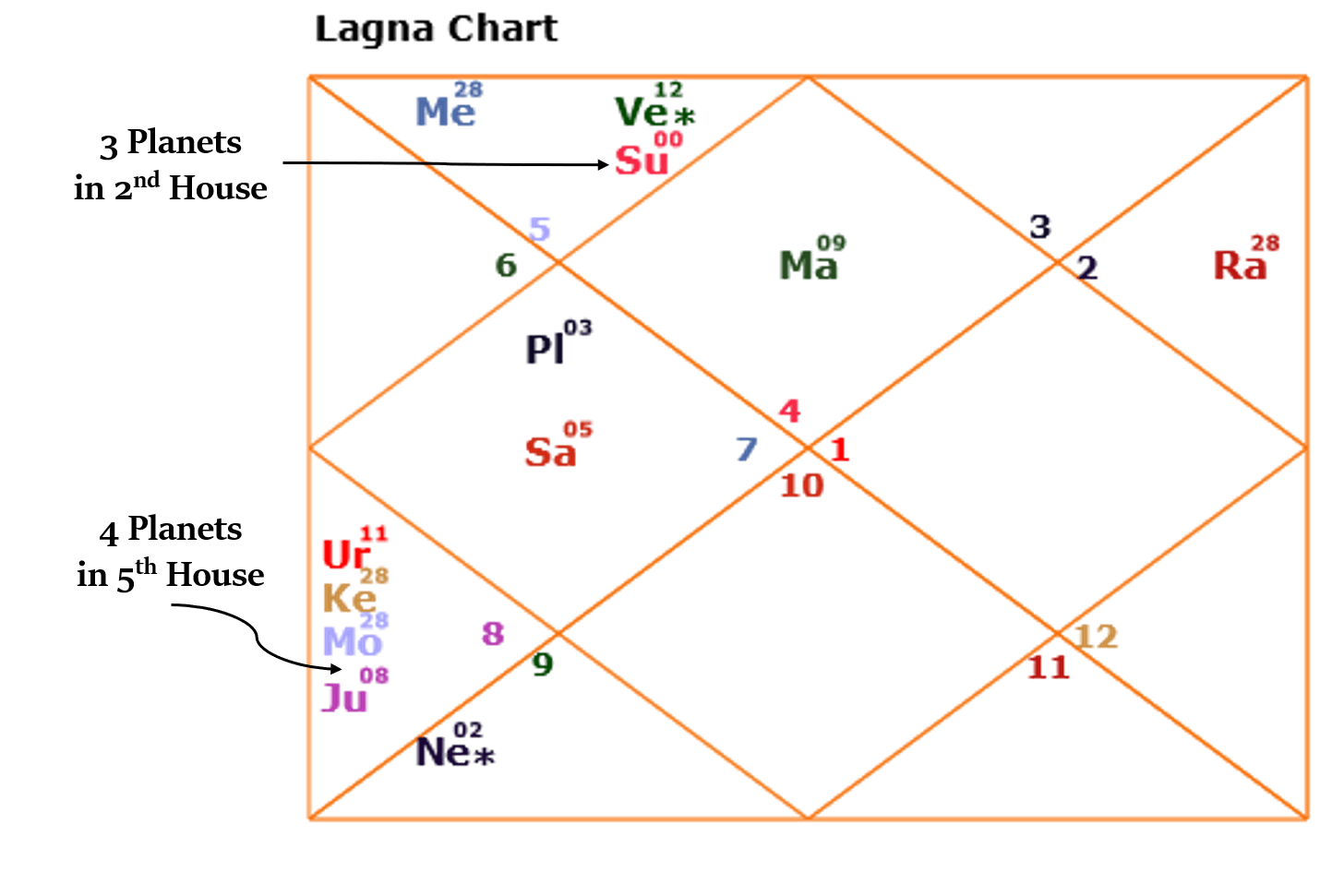Some Basic Yogs in Lagna Kundali
In previous articles, you were introduced to the basic rules of Lagna Kundali. If you haven’t read that, you may start by reading the basics of lagna kundali in this article. That article also tells you how we count houses in a kundali - a knowledge you need to have to understand this article.
However, just like English Grammer, there are a plethora of exceptions to almost every fundamental rule of Lagna Kundali.
In this article, we will go through some of such exceptions – often called as Yogs.
 Note
NoteDo not confuse the Yoga of Kundali, with the spiritual practice of Yoga. Yoga in Astrology/Kundali are specific combinations of planets and zodiac signs, that may act as an exception to the general rules. They may give good or bad results to a person.
 Table of Contents
Table of Contents- Rashi Parivartan Yog
- Vipreet Raj Yog
- State of the planets sitting with Sun
- Conjunction of Planets (Yuti)
Zodiac Sign Reversal Yog (Rashi Parivartan Yog)
If a planet A is sitting in the zodiac sign of planet B, and in turn planet B is sitting in the zodiac sign of planet A, then this situation is called Zodiac Sign Reversal Yog (Rashi Parivartan Yog).
What is its significance?
We know that, if a planet is sitting in the zodiac sign of its enemy planet, then it will do harm to that house of the kundali. However, if two enemy planets are sitting in each other’s zodiac signs, then they will not harm the house of each other.
You may imagine it to be a situation, wherein one person is holding his enemy’s family member at gun point, while the other person is also doing the same. It’s a stalemate situation. Nobody will do any harm.
For example, we know that Venus and Mars are enemy planets. However, if they are sitting in each other’s zodiac signs, then they will not do any harm. Say, if Venus is sitting in Scorpio zodiac sign (whose owner is Mars), and Mars is sitting in Libra zodiac sign (whose owner is Venus).
Vipreet Raj Yog
We know that 6th, 8th and 12th houses of the kundali are considered negative houses, as they are related to negative and bad aspects of our life.
However, if the zodiac sign (rashi) that is present in these houses, its owner planet is also sitting in one of these houses, then it will not give bad results. This is called Vipreet Rajyog.
For example, if Scorpio zodiac sign is present in the 8th house, then it should give bad results, as 8th house is a negative house. However, if in that kundali Mars (which is the owner of Scorpio zodiac sign) is sitting in either one of the 6th, 8th, or 12th house, then Scorpio zodiac sign will not give bad results related to the 8th house. It will rather give good results when Mahadasha of Mars will come in that person’s life. That’s because here Vipreet Raj Yog has been formed.
So, in short, if the owner of a bad house of the kundali is sitting in one of the bad houses, then it won’t give negative results, it won’t do any harm. In fact, it will rather give good results (when the Mahadasha of that planet will come).
But there are two added conditions:
- Lagnesh should be powerful, i.e. its degree should be good.
- Lagnesh should not be sitting in a negative house (i.e. in 6, 8, 12, or even 3).
If these conditions are not fulfilled, then Vipreet Raj Yog will not be formed.
 Note
NoteRahu and Ketu cannot for Vipreet Raj Yog, as they so not own any zodiac sign. So, if they are sitting in 6th, 8th or 12th houses of the kundali, then they will definitely give bad results.
 Lagnesh
LagneshLagnesh is the planet, that is the owner of the zodiac sign in the first house.
State of the planets sitting with Sun
We also need to look at the state of the planets sitting with the Sun more closely – i.e. whether they are setting (अस्त) or not.
If a planet is in the same house as Sun, and that planet is setting, then it will not give you good results, even if that planet is otherwise favourable to you.
Conjunction of Planets (Yuti)
If two or more planets are sitting in the same house, then those planets are said to be in Conjunction (or Yuti).
For example, consider the following Kundali:

Here, Mercury, Venus and Sun are in conjunction in the 2nd house. Similarly, Moon, Jupiter and Ketu are in conjunction in the 5th house.
The planet whose Mahadasha, or Antardasha will come, that planet will become active. The planet that is active will give its results.
If more than one planet is active, then we will have to see the combined effect of those planets.
 Pratiyuti
PratiyutiJust like the concept of conjunction/yuti, there’s a related concept of pratiyuti too. We already know, that each planet lays its sight on the 7th house from where it is sitting.
So, a planet will make a pratiyuti with the planet that is sitting in the 7th house from where it is sitting, i.e. where it lays its sight on.
For example, in the kundali given above, planets in the 5th house (Moon, Jupiter, Ketu) are in pratiyuti with the planet in the 11th house (Rahu).
